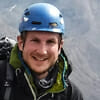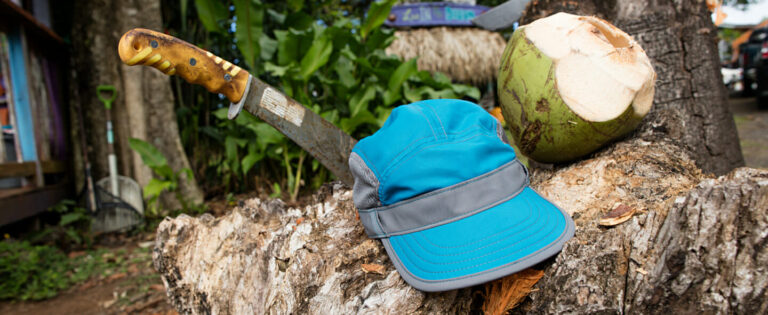Well, here we are, on the banks of Llyn Padarn in the small village of Llanberis, which is located in the land of unpronounceable words and place names. A few minutes later, we’re at a local climbing shop where we’re greeted with a grin. “Hey team ‘no shoes’. How are you doin’?“ Good thing we can laugh again. Shortly thereafter, we’re sat at the front door with our buddy Ben from DMM with three pairs of new climbing shoes, eating fish & chips, as Hazel Findlay walks by. A few chips go around before we pack our backpacks and head off into the evening for some climbing.

Why no shoes, you ask? Well, it all started a few hours ago: We arrive at the airport in Stuttgart, where we are forced to explain the unexplainable to airport security. Yes, the lump of metal in our duffle bags is for climbing. All we get is a look of disbelief. And yes, all the white powder in the little bags is for climbing, too! No, it’s not coke and it’s definitely not explosives! After making it through security, we board our plane to Manchester where we leaf through our Selective Guide for North Wales. Slate quarries, trad climbing, paying a visit to DMM and great weather – the next 4 days are looking good!
Upon arrival, though, reality sets in. None of our three checked bags even boarded the aeroplane. So, we go to the counter to express our dismay, only to find a bunch of other distraught passengers looking for their forgotten luggage as well.
After informing the airline that the lost luggage contains climbing equipment worth several thousand euros, we are assured that not only can we buy the essentials (all at the expense of an Irish budget airline that shall remain nameless) but our belongings will be forwarded to us as quickly as possible. So far, so good. So, we grab our hired car, whiz over to Wales and buy the essentials: climbing shoes and sleeping bags.
The first climb on Welsh rock
Fortunately, because this is an official visit to DMM with a small group of Alpinetrek employees, we don’t have to worry about there being a lack of quickdraws, cams and nuts.

They also let us rent some climbing harnesses, half ropes, helmets and the like thanks to Ben. He had already got us a discount and told the local climbing shop about our arrival. Pretty sweet. Kitted out and ready to go, we set off to finally lay our hands on these wonderful Welsh rocks ourselves!
For me personally, the first four pitches were my first in trad climbing, a great feeling – no bolts, no rules. Only one line among hundreds, as far as the natural structure goes. The only problem I have is that I don’t really trust my brand-spanking-new shoes from Scarpa yet, but that will come. So, there we stand, admiring the stunning view with a beautiful sunset at the edge of the valley.
One moment of happiness follows another
The next day, a glorious Sunday. Early in the morning the temperature climbs above 20°C, forcing us to seek out some of the few shady places there are to climb. My first trad lead climb – Whoop whoop! And that before breakfast!

As a reward, we get an English Breakfast with bacon, beans, eggs and sausages in the open air. Not everyone’s thing, but I love it! The wonderful scenery with Snowdon (1,085 m) in the immediate background is the icing on the cake. In general, you could say that North Wales is a true El Dorado for outdoor enthusiasts… We see mountain bikers, road cyclists, backpackers and above us there’s a single paraglider flying over the quarries. Oh, and the Atlantic is not far away either. There’s even supposed to be an artificial wave pool as well.
You’d think it’d be easy to find a good spot to climb, considering how nice the weather is, but’s just so hot. Beneath the clear sky in the famous dark grey slate quarries, you feel like you’re melting. But here, in the quarries, time seems to have stood. The area is riddled with abandoned mining structures, rusty rail and cable systems…did I mention the scorching heat? Being here is like travelling back in time, especially when you consider the fact that the Dinorwic quarry (formerly the second largest slate quarry in the world) has been abandoned since 1969.
Luckily, however, we have people with us who not only really know the area and its historical significance in climbing but also manage to find one of the few shady places to climb: the Serengeti. Here we spend the rest of the day with some of the rare bolted sport climbing routes and beautiful crack lines where we put almost the entire DMM line up of Dragon Cams, Wallnuts, Offset Nuts, Brass Offsets, Peenuts as well as I.M.P.’s to the test. An intro to climbing hardware at its finest!
Factory tour in Llanberis
At the start of the new week, we find ourselves in the DMM offices in Llanberis. We have the pleasure of chatting with various employees and product developers before taking a closer look at the heart of Welsh craftsmanship: the factory complete with their own CNC machine facility. Here is where DMM bends, presses and forges their carabiners, belay devices and pulleys and performs their quality controls.

The entire production cycle of DMM’s products takes place here. Due to environmental reasons, anodising is the only step in the production process that is carried out elsewhere. It is a really fascinating to see, especially considering the fact that all this hardware is stuff we trust with our lives!
Our long-lost luggage
Meanwhile at Manchester Airport: Our luggage is supposedly finally on its way here. How it’s going to get here and when it’s going to arrive remains a mystery. Anyway, since I only have one pair of underwear, I decide to go wash them in the lake. Probably not so good for the indigenous fauna, eh? Meh, I’m sure they’ll survive 😉 I guess I won’t worry about my t-shirt. We’re going to be on the move all day anyway – a fresh tee won’t make much of a difference.

What I do miss, though, is a decent pair of approach shoes. My sneakers are comfortable, but less suitable for hiking. In the afternoon, we’re going to the Idwall slabs which has quite a few really nice, moderately difficult pitches (VD – HVS). Perfect for experimenting with mobile belay techniques. And so, the hours pass, and before we know it, it’s early in the evening.
Only after hearing the thundering roar of a twin-prop aircraft from the Royal Air Force do we look at the fire-red horizon and realise it’s time for us to pack up and go home.
Off to the Rainbow Slab Area with self-made carabiners

It’s our last day before we head back to Germany, and still there’s no trace of our luggage, but we don’t really care at this point. In the morning, we head to DMM again. One of the many highlights of our trip was the opportunity to assemble half a dozen carabiners each under the watchful eye of our friends at DMM, complete with official approval, laser engraving and random tests of their breaking strength. It’s quite impressive how much the carabiners and slings can take before they break and what a negative impact external factors, such as ageing, UV rays and corrosion have on their ratings.
Bursting with confidence in our new hardware, we do the first thing that comes to mind – we go climbing! Our goal today: the Rainbow Slab Area. When we arrive, we lay eyes on the prominent crack line running up the centre of the rainbow slab. We climb „Bela Lugosi is Dead“ (E1 5b), a stunning route, using basically all the gear our harnesses can hold, including everything from cams and medium-sized nuts to really small brass offsets.

Now, we’ve all got trad fever. Or to put it in the words of our climbing guide: “The Rainbow Slab itself is mostly old-school trad classics with minimal or no bolting giving run-out and technical routes requiring deft footwork, strong fingers and a very steady head”. There is no better way to describe the huge differences there are between trad climbing and the traditional sport climbing we know here in Germany. At nightfall, we leave the area and treat ourselves to plenty of celebratory Guinness, cider and fish & chips!
Wales, we’ll be back
Before we head back to Germany, we quickly test one or two boulders and then say goodbye to Ben and DMM with a huge thank you (not least for all the gear we borrowed). In the car, we find out that our luggage is on its way to Wales. Yeah, thanks for nothing, cheap airline from Ireland, whose name shall, once again, remain nameless. An entire week goes by before we get our beloved half ropes, climbing shoes and racks of trad gear back.
Despite the less than optimal experience with the airline, we only have positive memories of our trip to Wales. I think I can speak for all my fellow travellers when I say that the trip was an absolute success and extremely informative. Wales, we’ll be back!







